Experimental Study on Rockfall Mechanism of Platy Rock on a Complex Slope
Abstract
1. Introduction
2. Model Experiment
2.1. Model Experiment System
2.1.1. Slope Model
2.1.2. Block Release Device
2.1.3. Data Acquisition System
2.2. Experimental Procedure
3. Experimental Results and Analysis
3.1. Rockfall Movement Trajectory
3.2. Stopping Position Analysis of Platy Rock Rockfall
3.3. Collision Position Analysis of Platy Rock Movement
3.4. The Analysis of Restitution Coefficient
4. Discussion
5. Conclusions
Author Contributions
Funding
Conflicts of Interest
References
- China Geological Environment Information Site. Available online: http://219.142.70.148/auto/db/explorer.html?db=1006&type=1&fd=16&fv=49&uni=0&md=15&pd=210&mdd=11&pdd=5&msd=11&psd=5&start=0&count=20 (accessed on 23 December 2019).
- Labiouse, V.; Heidenreich, B. Half-scale experimental study of rockfall impacts on sandy slopes. Nat. Hazards Earth Syst. Sci. 2009, 9, 1981–1993. [Google Scholar] [CrossRef]
- Asteriou, P.; Tsiambaos, G. Effect of impact velocity, block mass and hardness on the coefficients of restitution for rockfall analysis. Int. J. Rock Mech. Min. Sci. 2018, 106, 41–50. [Google Scholar] [CrossRef]
- Azzoni, A.; La Barbera, G.; Zaninetti, A. Analysis and prediction of rockfalls using a mathematical model. Int. J. Rock Mech. Min. Sci. Geomech. Abstr. 1995, 32, 709–724. [Google Scholar] [CrossRef]
- Buzzi, O.; Giacomini, A.; Spadari, M. Laboratory Investigation on High Values of Restitution Coefficients. Rock Mech. Rock Eng. 2011, 45, 35–43. [Google Scholar] [CrossRef]
- Chau, K.; Wong, R.; Wu, J. Coefficient of restitution and rotational motions of rockfall impacts. Int. J. Rock Mech. Min. Sci. 2002, 39, 69–77. [Google Scholar] [CrossRef]
- Ferrari, F.; Giacomini, A.; Thoeni, K.; Lambert, C. Qualitative evolving rockfall hazard assessment for highwalls. Int. J. Rock Mech. Min. Sci. 2017, 98, 88–101. [Google Scholar] [CrossRef]
- Giacomini, A.; Buzzi, O.; Renard, B.; Giani, G.P. Experimental studies on fragmentation of rock falls on impact with rock surfaces. Int. J. Rock Mech. Min. Sci. 2009, 46, 708–715. [Google Scholar] [CrossRef]
- Giacomini, A.; Thoeni, K.; Lambert, C.; Booth, S.; Sloan, S.W. Experimental study on rockfall drapery systems for open pit highwalls. Int. J. Rock Mech. Min. Sci. 2012, 56, 171–181. [Google Scholar] [CrossRef]
- Giani, G.; Giacomini, A.; Migliazza, M.; Segalini, A. Experimental and theoretical studies to improve rock fall analysis and protection work design. Rock Mech. Rock Eng. 2004, 37, 369–389. [Google Scholar] [CrossRef]
- Hu, J.; Li, S.; Li, L.; Shi, S.; Zhou, Z.; Liu, H.; He, P. Field, experimental, and numerical investigation of a rockfall above a tunnel portal in southwestern China. Bull. Eng. Geol. Environ. 2017, 77, 1365–1382. [Google Scholar] [CrossRef]
- Li, L.-P.; Sun, S.-Q.; Li, S.-C.; Zhang, Q.-Q.; Hu, C.; Shi, S.-S. Coefficient of restitution and kinetic energy loss of rockfall impacts. KSCE J. Civ. Eng. 2016, 20, 2297–2307. [Google Scholar] [CrossRef]
- Li, S.; Wang, Q.; Wang, H.; Jiang, B.; Wang, D.; Zhang, B.; Li, Y.; Ruan, G. Model test study on surrounding rock deformation and failure mechanisms of deep roadways with thick top coal. Tunn. Undergr. Space Technol. 2015, 47, 52–63. [Google Scholar] [CrossRef]
- Hu, J.; Li, S.-C.; Shi, S.-S.; Li, L.-P.; Liu, J.-P.; Liu, H.-L.; He, P. Model test study of rockfall impacts on tunnel heading slope and discussion of related mechanisms. Rock Soil Mech. 2018, 39, 2527–2536. (In Chinese) [Google Scholar]
- Zhang, L.T.; Qi, Q.L.; Li, Q.; Zhang, S.X.; Liu, Y.B. Experimental model study on dam break and evolution law of tailings pond J. J. Hydraul. Eng. 2016, 47, 229–235. (In Chinese) [Google Scholar]
- He, S.-M.; Wu, Y.; Shen, J. Research on restitution coefficient of rock fall. Rock Soil Mech. 2009, 30, 623–627. (In Chinese) [Google Scholar]
- Ye, S.; Gong, S. Research on Normal Restitution Coefficient of Rockfall Collision by Model Tests. China Railw. Sci. 2015, 36, 13–19. (In Chinese) [Google Scholar]
- Shen, W.; Zhao, T.; Tang, C.; Dai, F. Loading Rate Dependency of Impact Induced Rock Fragmentation during Rockfall. Adv. Eng. Sci. 2018, 50, 43–50. (In Chinese) [Google Scholar]
- Yao, W.; Yue, W. Advance in controversial restitution coefficient study for impact problems. J. Vib. Shock 2015, 34, 43–48. (In Chinese) [Google Scholar]
- Huang, X.F.; Zhang, Y.B.; Zhao, X.Q.; Yu, P.C.; Chen, Y.Y. A preliminary study the of kinetic characteristic of rock-fall under seismic loading. Rock Soil Mech. 2017, 38, 583–592. (In Chinese) [Google Scholar]
- Ye, Y.; Zeng, Y.; Peng, Z.X. Experimental study on the normal coefficient of restitution and fragmenting of marble spheres. Chin. J. Rock Mech. Eng. 2018, 037, 1680–1690. (In Chinese) [Google Scholar]
- Ye, Y.; Zeng, Y.; Zeng, C. Experimental study on the normal restitution coefficient of granite spheres. Chin. J. Rock Mech. Eng. 2017, 36, 633–643. (In Chinese) [Google Scholar]
- Zhang, Y.; Hu, Z.; Xue, Z. A new method of assessing the collapse sensitivity of loess. Bull. Eng. Geol. Environ. 2018, 77, 1287–1298. [Google Scholar] [CrossRef]
- Yong, Z.L.; Ming, L.J.; Jun, W.H. Physical Simulation of High Slope Deformation Failure Induced by Strong Seismicity. Soil Eng. Found. 2011, 25, 40–43. (In Chinese) [Google Scholar]
- Liu, Y.-P.; Huang, R. Study on physical simulation vibration test of the anti-inclined slab-rent structure rock slope. J. Chengdu Univ. Technol. Sci. Technol. Ed. 2011, 38, 413–421. (In Chinese) [Google Scholar]
- Ya, Z.; Li, L.; Hu, B.; Su, Y. Three new research directions worthy of attention in engineering geology field—To commemorate the 60th anniversary of CAS engineering geology laboratory. J. Eng. Geol. 2018, 26, 1–9. (In Chinese) [Google Scholar]
- Glover, J.; Schweizer, A.; Christen, M.; Gerber, W.; Leine, R.; Bartelt, P. Numerical investigation of the influence of rock shape on rockfall trajectory. EGU Gen. Assem. Conf. Abstr. 2012, 14, 11022. [Google Scholar]
- Axel, V.; Lucas, B.; Fabio, G.; Werner, G.; Barbara, K.; Peter, K.; Jessica, L.; Geosciences, S.T.J. Repetitive Rockfall Trajectory Testing. Geosciences 2018, 8, 88. [Google Scholar]
- Bourrier, F.; Berger, F.; Tardif, P.; Dorren, L.; Hungr, O. Rockfall rebound: Comparison of detailed field experiments and alternative modelling approaches. Earth Surf. Process. Landf. 2012, 37, 656–665. [Google Scholar] [CrossRef]
- Heiss, C. Die Prüfung flexibler Steinschlagschutzsysteme nach der ETAG 027 und das Funktionsprinzip derartiger Systeme am Beispiel der Produktreihe TSC-xxxx-ZD. BHM Berg-und Hüttenmännische Mon. 2011, 156, 57–62. [Google Scholar] [CrossRef]
- Glover, J.M.H. Rock-Shape and Its Role in Rockfall Dynamics. Ph.D. Thesis, Durham University, Durham, UK, 2015. [Google Scholar]
- Heidenreich, B. Small- and Half-Scale Experimental Studies of Rockfall Impacts on Sandy Slopes; EPFL: Lausanne, Switzerland, 2004. [Google Scholar]
- Nagendran, S.K.; Ismail, M.A.M. Analysis of Rockfall Hazards Based on the Effect of Rock Size and Shape. Int. J. Civ. Eng. 2019, 17, 1919–1929. [Google Scholar] [CrossRef]
- Yu, B.; Yi, W.; Zhao, H. Experimental study on the maximum impact force by rock fall. Landslides 2018, 15, 233–242. [Google Scholar] [CrossRef]
- Hu, J.; Li, S.; Shi, S.; Li, L.; Zhang, Q.; Liu, H.; He, P. Experimental study on parameters affecting the Runout range of rockfall. Adv. Civ. Eng. 2018, 2018, 1–9. [Google Scholar] [CrossRef]
- Azzoni, A.; Drigo, E.; Giani, G.; Rossi, P.; Zaninetti, A. In situ observation of rockfall analysis. In Proceedings of the 6th International Symposium on Landslides, Christchurch, New Zealand, 10–14 February 1992; pp. 307–314. [Google Scholar]
- Spadari, M.; Giacomini, A.; Buzzi, O.; Fityus, S.; Giani, G. In situ rock fall tests in New South Wales, Australia. Int. J. Rock Mech. Min. Sci. 2012, 49, 84–93. [Google Scholar] [CrossRef]
- Bourrier, F.; Dorren, L.; Nicot, F.; Berger, F.; Darve, F. Toward objective rockfall trajectory simulation using a stochastic impact model. Geomorphology 2009, 110, 68–79. [Google Scholar] [CrossRef]
- Mathon, C.; Kobayashi, H.; Dewez, T.; Sedan, O.; Nachbaur, A.; Berger, F.; Desgarets, E.; Nowak, E. Calibration of restitution coefficients, based on real size experiment in the weathered volcanic context of Tahiti, French Polynesia. In Proceedings of the Rock Slope Stability, Paris, France, 2010. [Google Scholar]
- Paronuzzi, P. Field evidence and kinematical back analysis of block rebounds: The Lavone rockfall, Northern Italy. Rock Mech. Rock Eng. 2009, 42, 783–813. [Google Scholar] [CrossRef]
- Wang, C.; Li, X.; Sheng, Q. Aerial Photogrammetry; Yellow River Conservancy Press: Zhengzhou, China, 2011. [Google Scholar]
- Jin, T.; Tong, S. Reverse Engineering; Mechanical Industry Press: Beijing, China, 2003. [Google Scholar]
- Shan, Y.; Xie, B. Imageware Technical Basis of Reverse Molding; Tsinghua University Press: Beijing, China, 2006. [Google Scholar]
- Basson, F. Rigid body dynamics for rock fall trajectory simulation. In Proceedings of the 46th US Rock Mechanics/Geomechanics Symposium, Chicago, IL, USA, 24–27 June 2012. [Google Scholar]
- Huang, R.Q.; Liu, W.; Zhou, J.P.; Pei, X. Rolling tests on movement characteristics of rock blocks. Chin. J. Geotech. Eng. 2007, 29, 1296–1302. (In Chinese) [Google Scholar]
- Wong, R.H.; Ho, K.W.; Chau, K.T. Shape and mechanical properties of slope material effects on the coefficient of restitution on rockfall study. In Proceedings of the 4th North American Rock Mechanics Symposium, Seattle, WA, USA, 31 July–3 August 2000; pp. 507–514. [Google Scholar]
- Chau, K.T.; Wong, R.H.C.; Liu, J.; Wu, J.J.; Lee, C.F. Shape effects on the coefficient of restitution during rockfall impacts. In Proceedings of the 9th International Congress on Rock Mechanics, Paris, France, 25–28 August 1999; pp. 541–544. [Google Scholar]
- Ushiro, T.; Shinohara, S.; Tanida, K.; Yagi, N. A Study on the Motion of Rockfalls on Slopes. In Proceedings of the 5th Symposium on Impact Problems in Civil Engineering, Tokyo, Japan, June 2000; pp. 91–96. [Google Scholar]
- Pfeiffer, T.; Bowen, T. Computer Simulation of Rockfalls. Bull. Assoc. Eng. Geol. 1989, 26, 135–146. [Google Scholar] [CrossRef]
- Fornaro, M.; Peila, D.; Nebbia, M. Block falls on rock slopes—Application of a numerical simulation program to some real cases. In Proceedings of the International Congress International Association of Engineering Geology, Amsterdam, The Netherlands, 6–10 August 1990; pp. 2173–2180. [Google Scholar]
- Chau, K.T.; Wu, J.J.; Wong, R.H.; Lee, C.F. The coefficient of restitution for boulders falling onto soil slopes with various values of dry density and water content. In Proceedings of the International Symposium on Slope Stability Engineering: Geotechnical and Geoenvironmental Aspects, Matsuyama, Shikoku, Japan, 8–11 November 1999; pp. 355–1360. [Google Scholar]
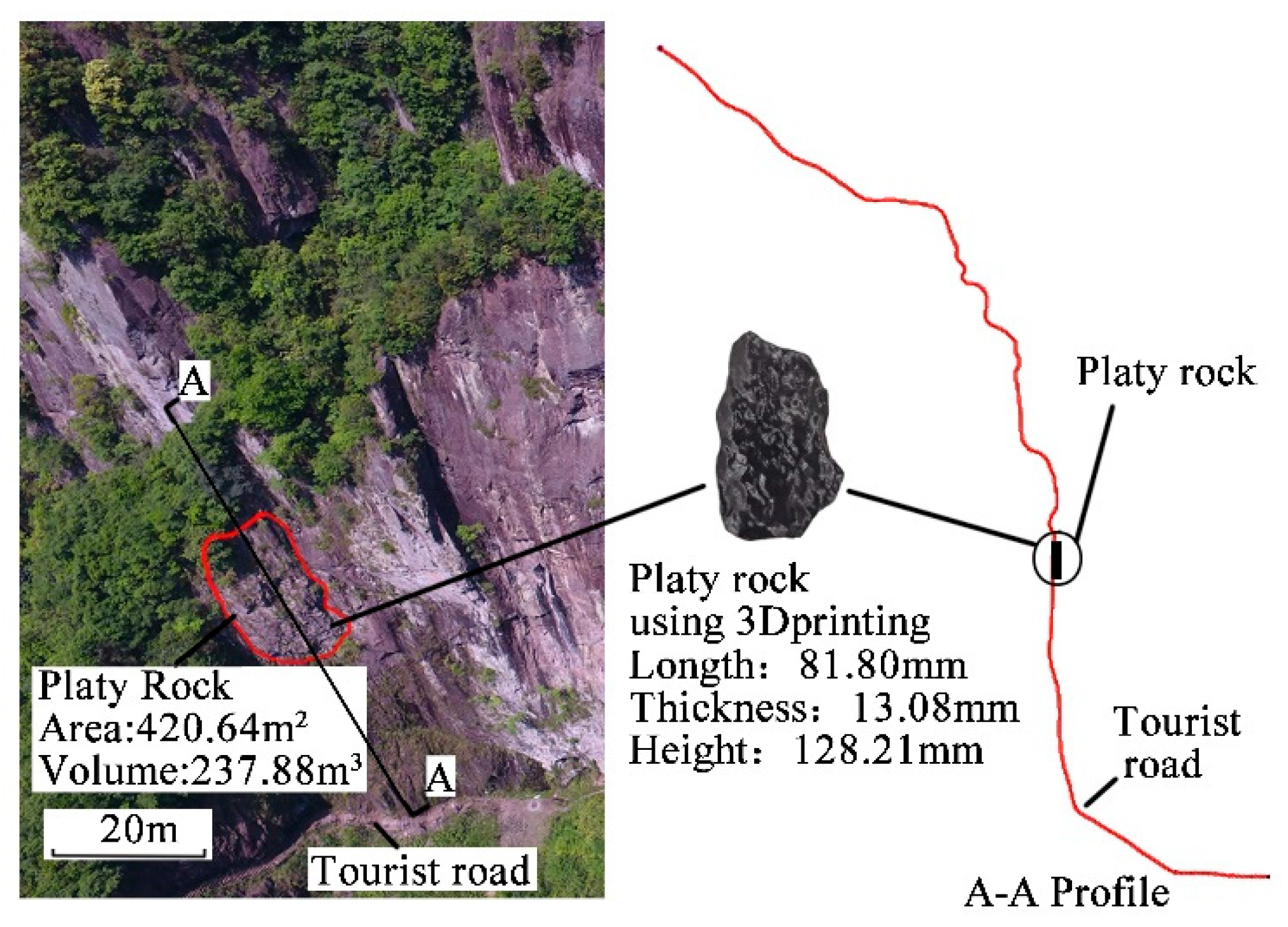
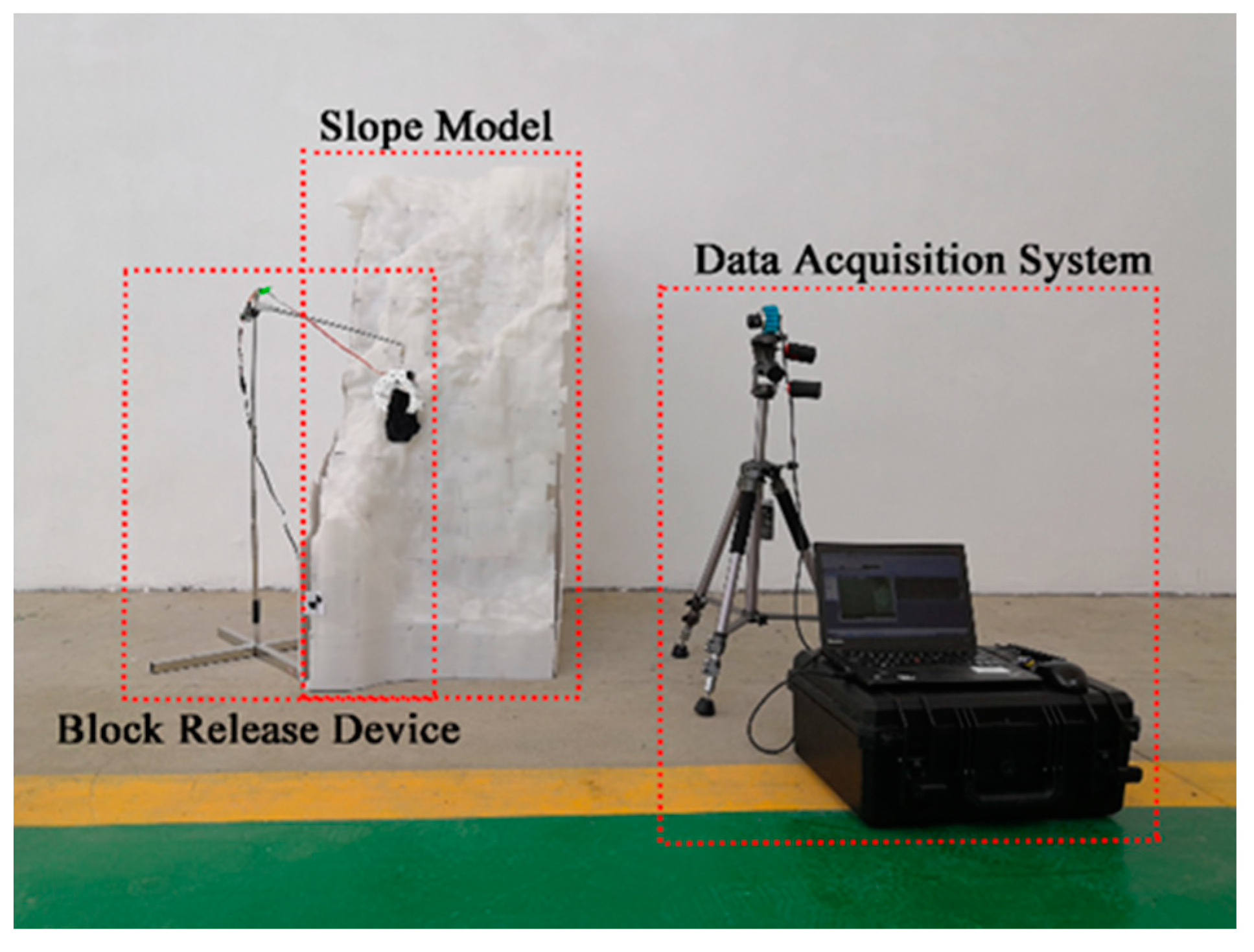

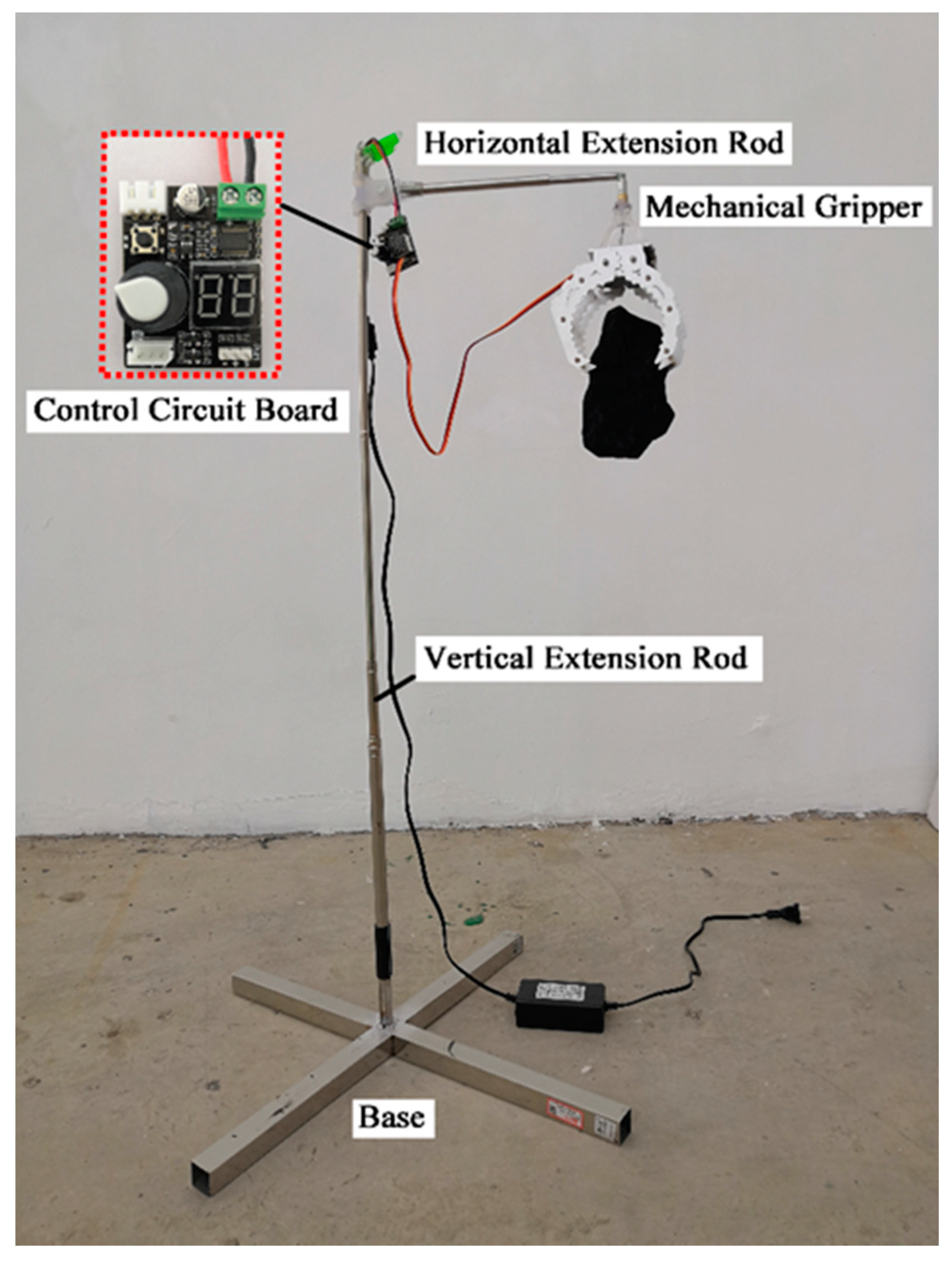
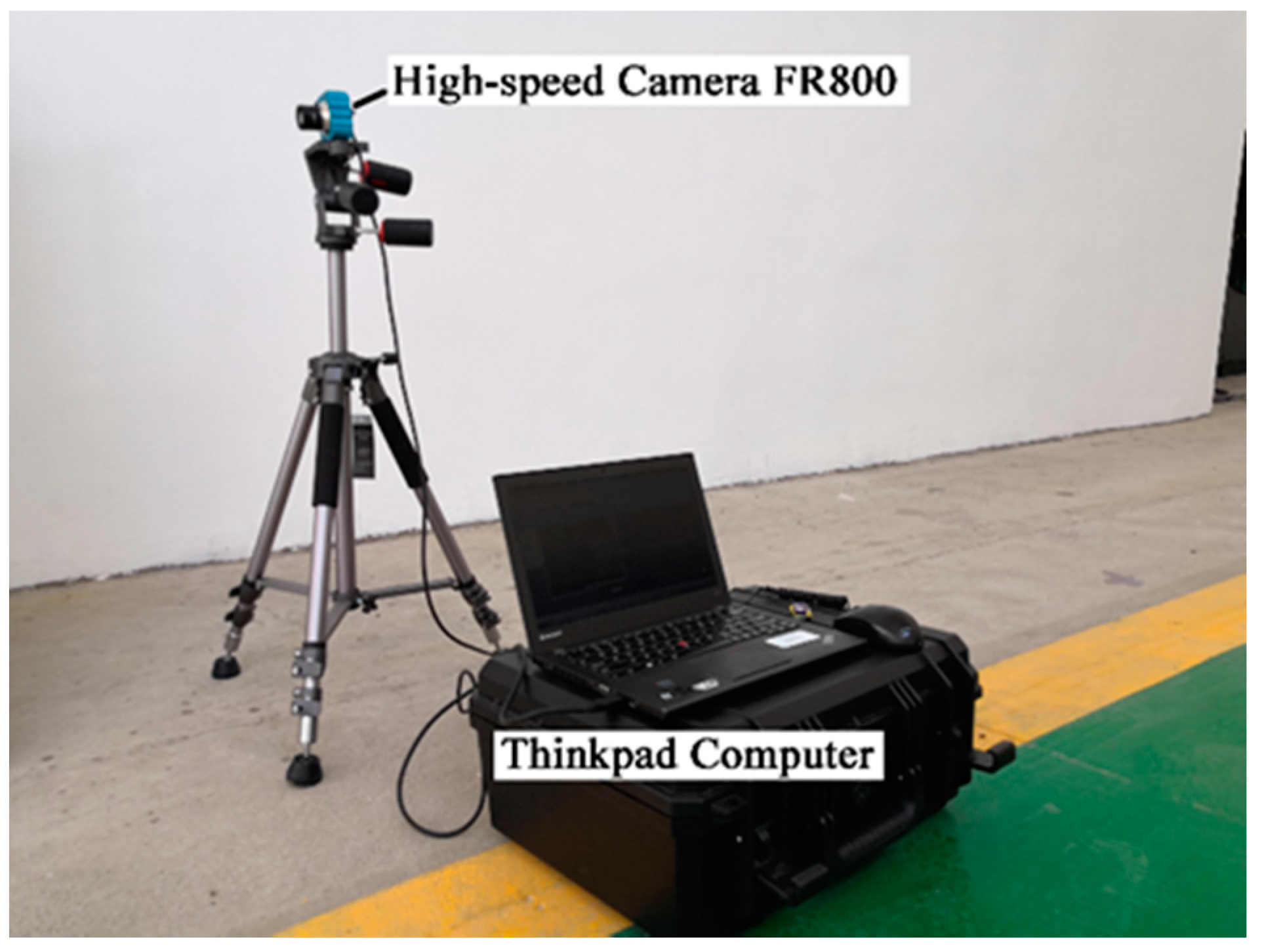

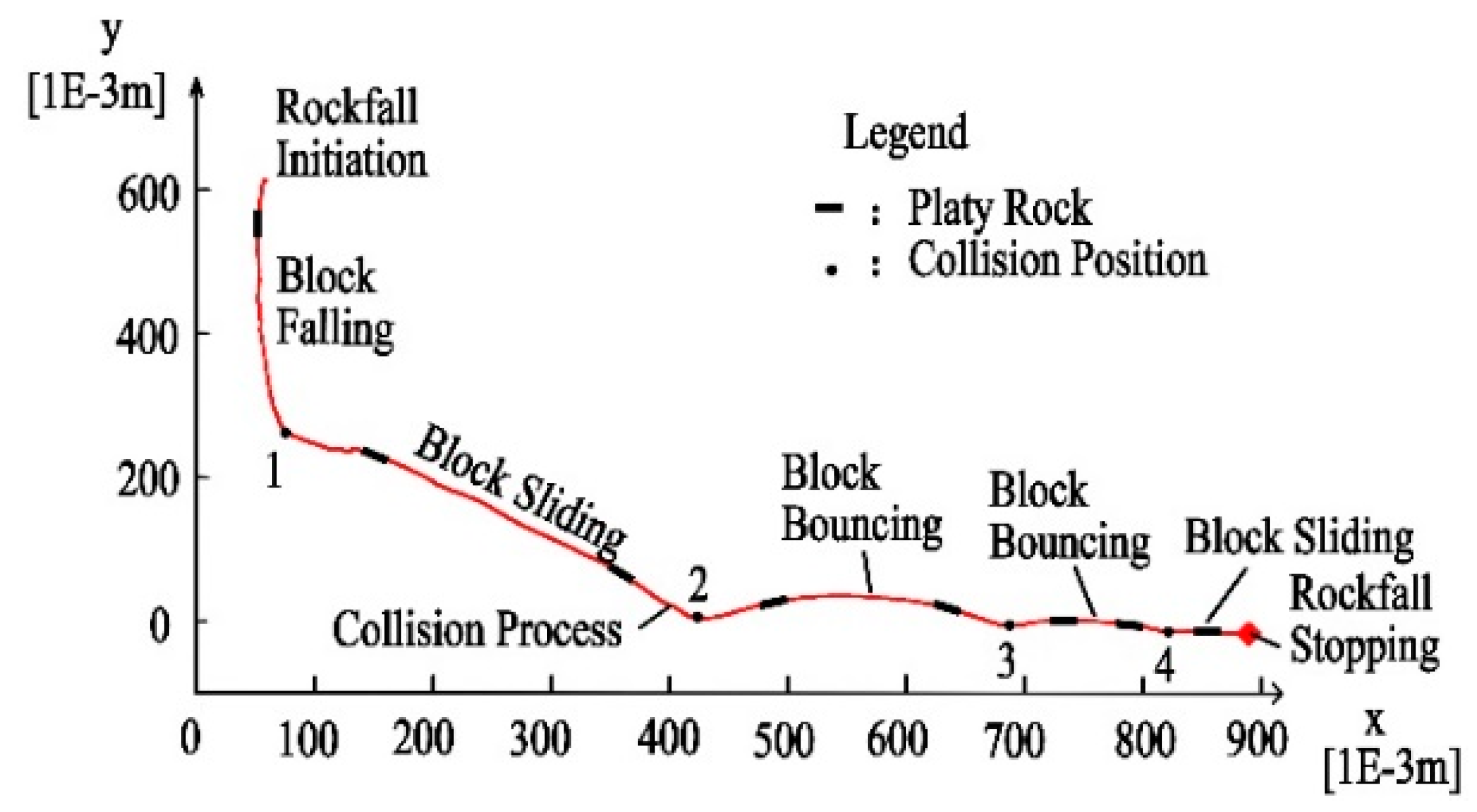
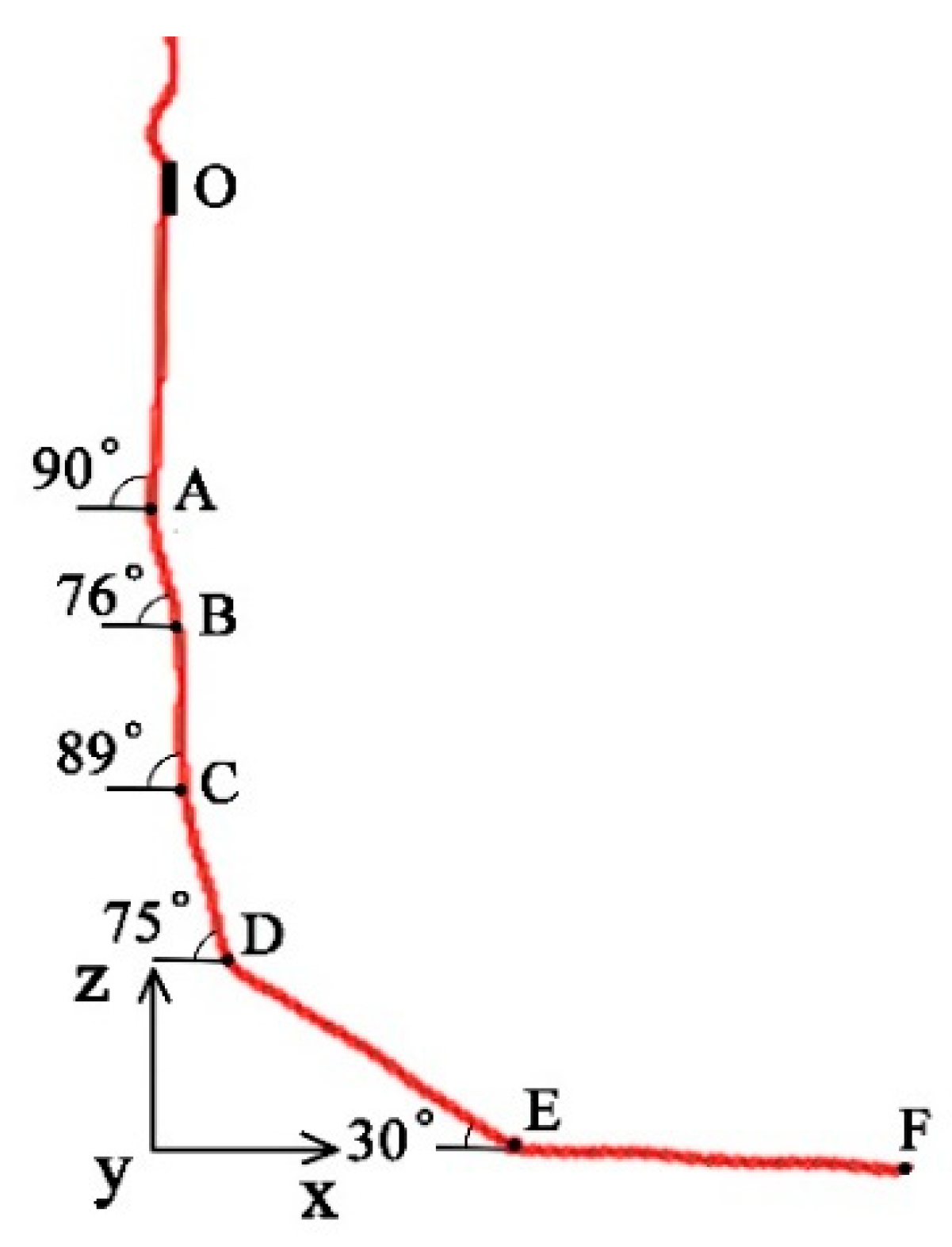
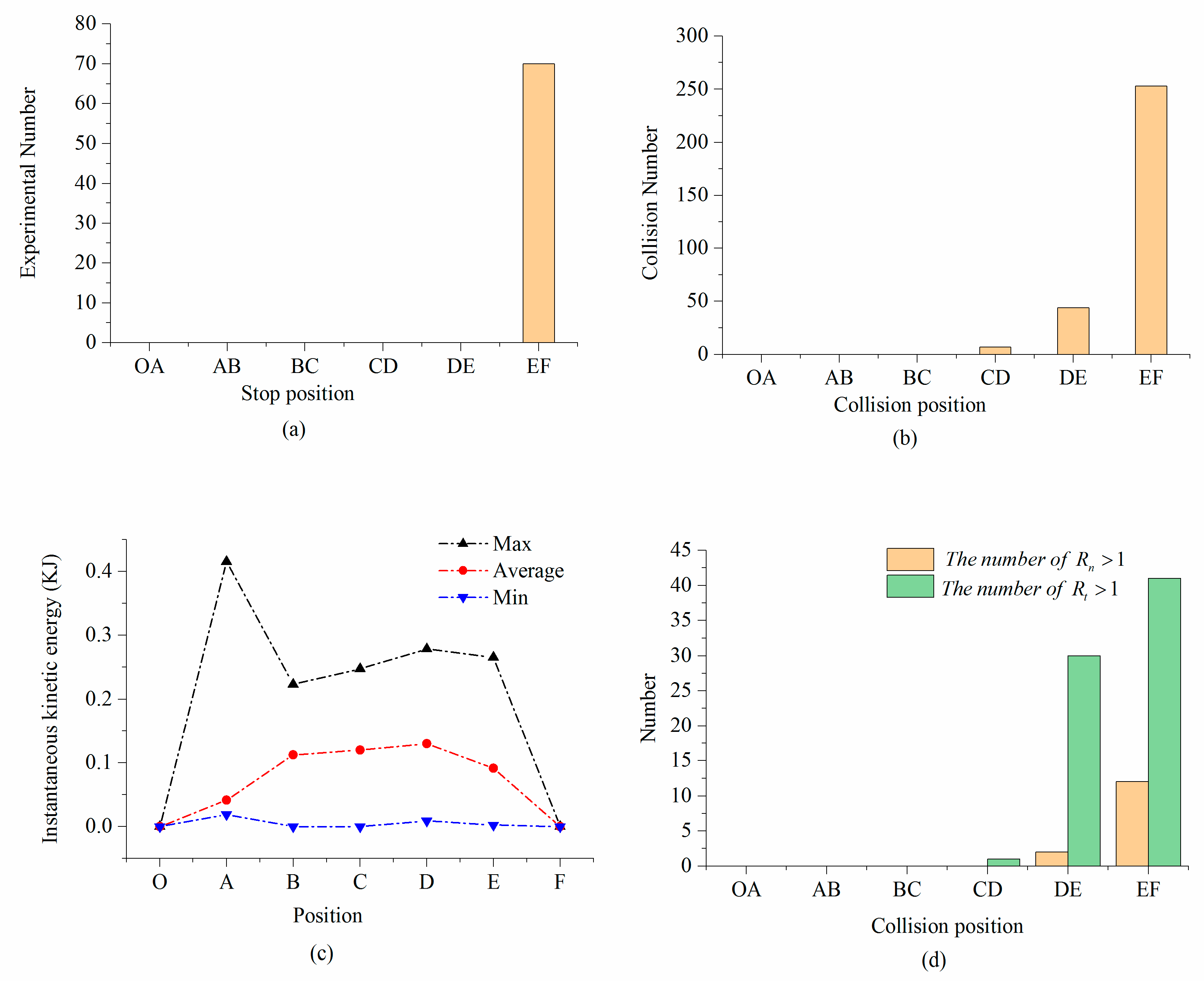
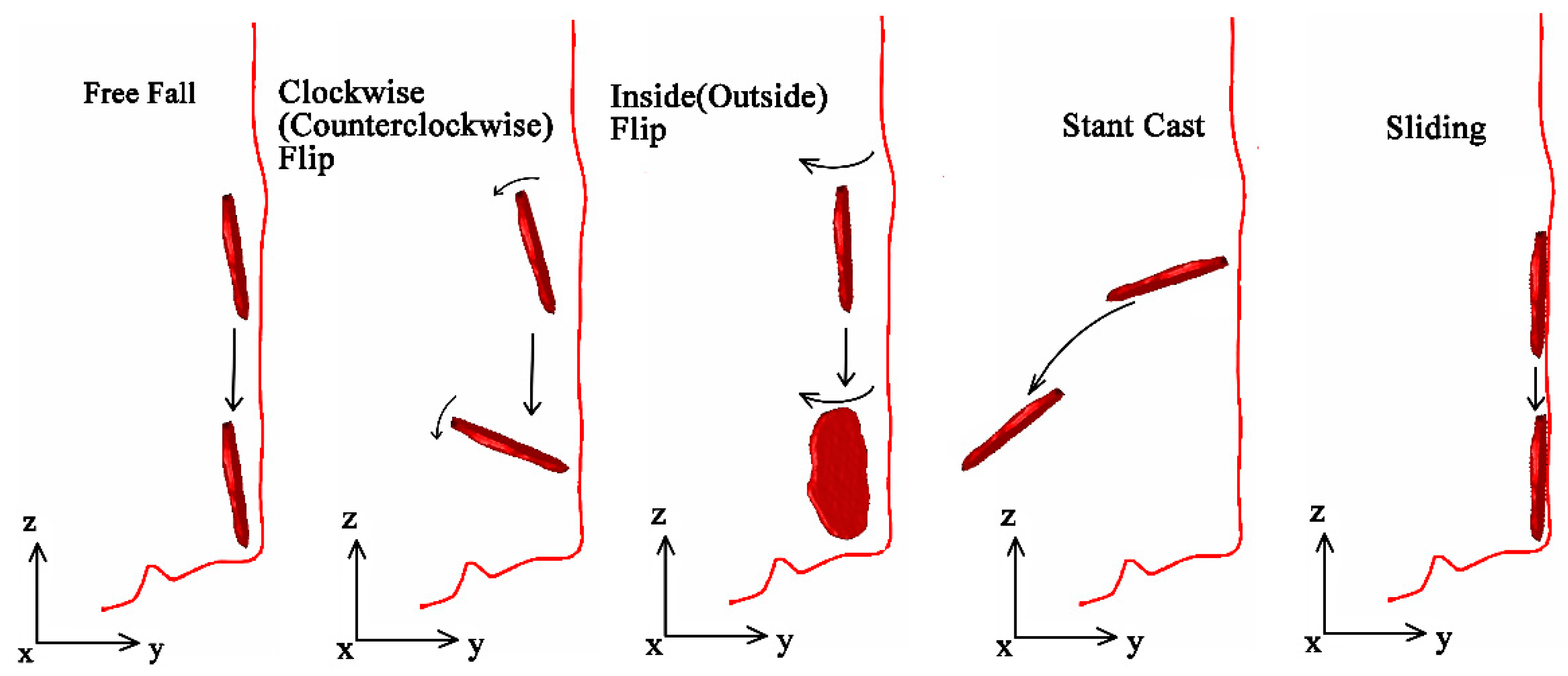
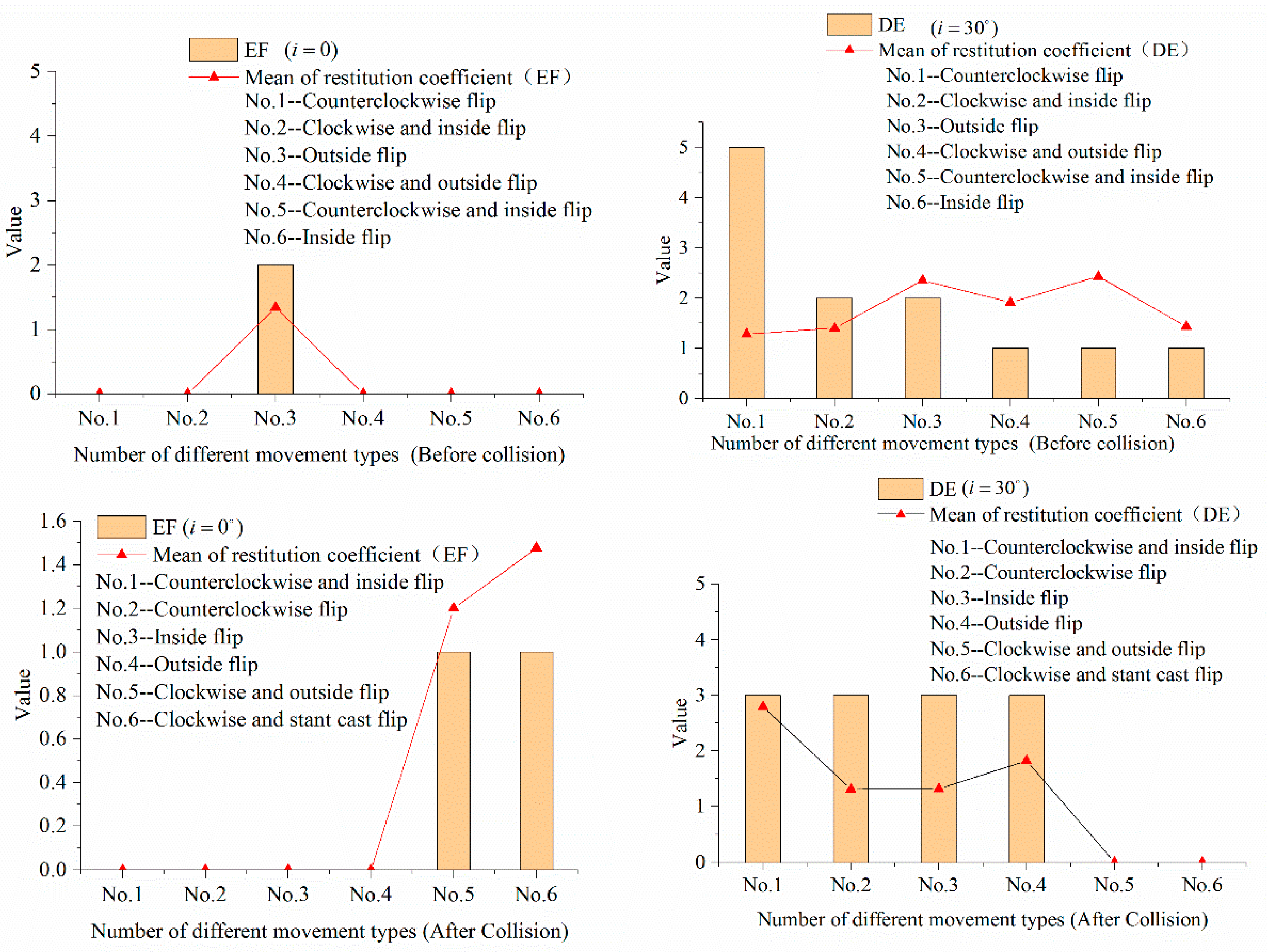
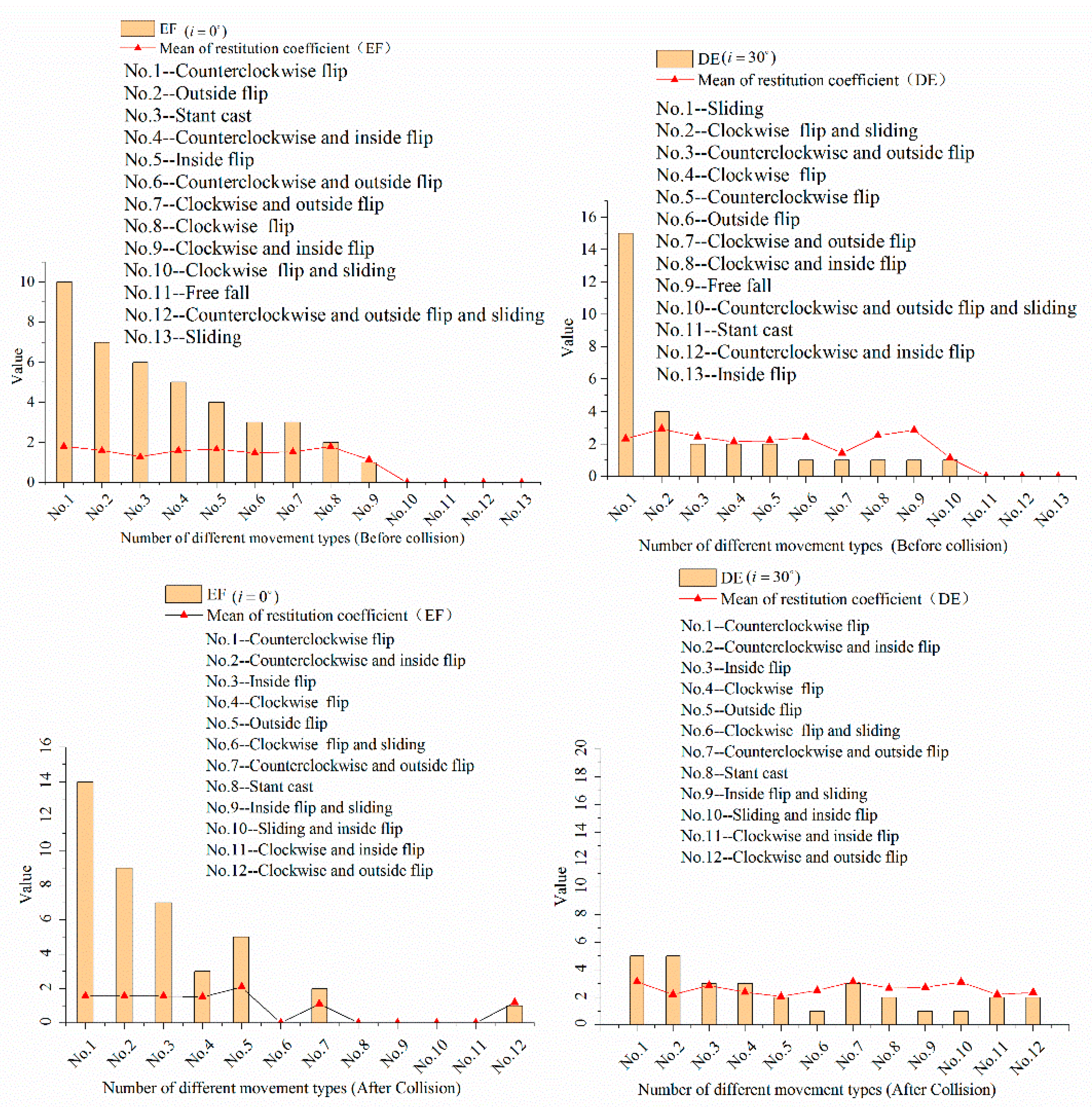
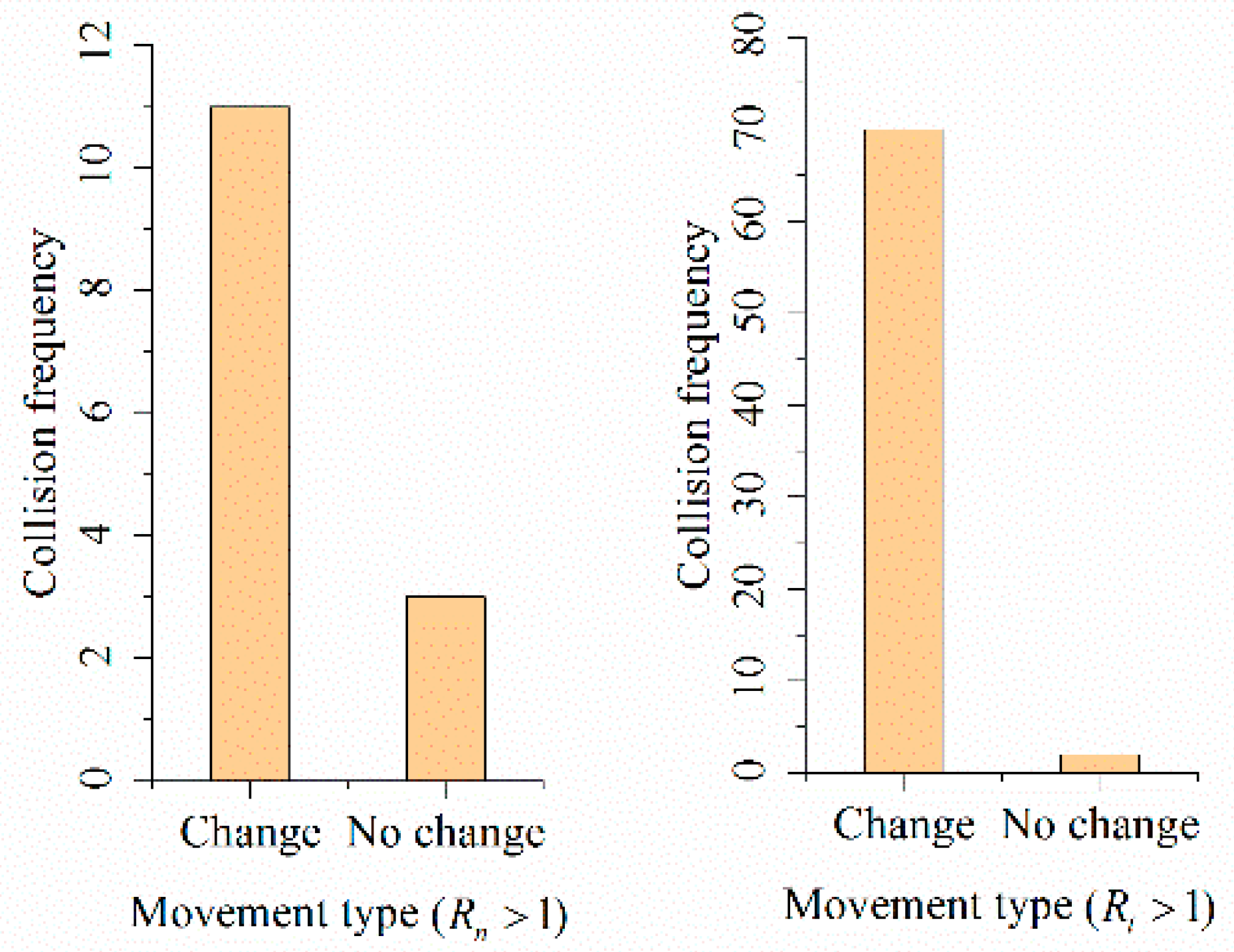
| Indicators | Physical Quantities | Slope Prototype (Tuff) | Physical Model (PLA) | Similarity Constants |
|---|---|---|---|---|
| Material Parameters | Modulus of Elasticity | 7.73 × 109 | 3.48 × 109 | |
| Density | 2892 | 1000 | ||
| Geometric Features | Width | 84 | 0.56 | |
| Height | 240 | 1.6 |
© 2020 by the authors. Licensee MDPI, Basel, Switzerland. This article is an open access article distributed under the terms and conditions of the Creative Commons Attribution (CC BY) license (http://creativecommons.org/licenses/by/4.0/).
Share and Cite
Liao, X.; Ouyang, Q.; Liu, H.; Sun, J.; Wang, X.; Li, L.; Yang, Z.; Chen, Z. Experimental Study on Rockfall Mechanism of Platy Rock on a Complex Slope. Appl. Sci. 2020, 10, 2849. https://doi.org/10.3390/app10082849
Liao X, Ouyang Q, Liu H, Sun J, Wang X, Li L, Yang Z, Chen Z. Experimental Study on Rockfall Mechanism of Platy Rock on a Complex Slope. Applied Sciences. 2020; 10(8):2849. https://doi.org/10.3390/app10082849
Chicago/Turabian StyleLiao, Xiaohui, Qi Ouyang, Haiyang Liu, Juanjuan Sun, Xueliang Wang, Lihui Li, Zhifa Yang, and Zigan Chen. 2020. "Experimental Study on Rockfall Mechanism of Platy Rock on a Complex Slope" Applied Sciences 10, no. 8: 2849. https://doi.org/10.3390/app10082849
APA StyleLiao, X., Ouyang, Q., Liu, H., Sun, J., Wang, X., Li, L., Yang, Z., & Chen, Z. (2020). Experimental Study on Rockfall Mechanism of Platy Rock on a Complex Slope. Applied Sciences, 10(8), 2849. https://doi.org/10.3390/app10082849





